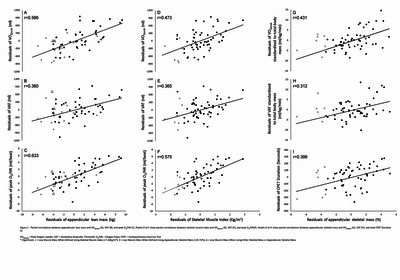Nicols, Simon, O'Doherty, Alasdair, Taylor, Claire, Clarke, Andrew, Carroll, Sean and Ingle, Lee (2019) Low skeletal muscle mass is associated with low aerobic capacity and increased mortality risk in patients with coronary heart disease - A CARE CR Study. Clinical Physiology and Functional Imaging, 39 (1). pp. 93-102. ISSN 1475-0961
|
Text
Nichols_et_al-2018-Clinical_Physiology_and_Functional_Imaging.pdf - Published Version Available under License Creative Commons Attribution 4.0. Download (225kB) | Preview |
|
![[img]](/35336/2.hassmallThumbnailVersion/Figure_1_Final%20%281%29.jpg)
|
Image
Figure_1_Final (1).jpg - Accepted Version Download (412kB) | Preview |
|
|
Text
Muscle_Mass_and_CHD_Paper_Full_Manuscript.pdf - Accepted Version Download (421kB) | Preview |
Abstract
Background: In patients with chronic heart failure, there is a positive linear relationship between skeletal muscle mass (SMM) and peak oxygen consumption (V̇O2peak); an independent predictor of all-cause mortality. We investigated the association between SMM and V̇O2peak in patients with coronary heart disease (CHD) without a diagnosis of heart failure. Methods: Male patients with CHD underwent maximal cardiopulmonary exercise testing and dual X-ray absorptiometry assessment. V̇O2peak, the ventilatory anaerobic threshold and peak oxygen pulse (peak V̇O2/HR) were calculated. SMM was expressed as appendicular lean mass (lean mass in both arms and legs) and reported as skeletal muscle index (SMI; kg/m2), and as a proportion of total body mass (appendicular skeletal mass [ASM%]). Low SMM was defined as a SMI<7.26 kg/m2, or ASM% <25.72%). 5-year all-cause mortality risk was calculated using the Caliber 5-year all-cause mortality risk score. Results: Sixty patients were assessed. Thirteen (21.7%) had low SMM. SMI and ASM% correlated positively with V̇O2peak (r=0.431 and 0.473, respectively; P<0.001 for both). SMI and ASM% predicted 16.3% and 12.9% of the variance in V̇O2peak, respectively. SMI correlated most closely with peak V̇O2/HR (r=0.58; p<0.001). SMI predicted 40.3% of peak V̇O2/HR variance. ASM% was inversely associated with 5-year all-cause mortality risk (r=-0.365; P=0.006).Conclusion: SMM was positively correlated with V̇O2peak in patients with CHD. Peak V̇O2/HR had the strongest association with SMM. Low ASM% was associated with a higher risk of all-cause mortality. The effects of exercise and nutritional strategies aimed at improving SMM and function in CHD patients should be investigated.
| Item Type: | Article |
|---|---|
| Subjects: | B100 Anatomy, Physiology and Pathology |
| Department: | Faculties > Health and Life Sciences > Sport, Exercise and Rehabilitation |
| Depositing User: | Becky Skoyles |
| Date Deposited: | 15 Aug 2018 08:41 |
| Last Modified: | 01 Aug 2021 11:18 |
| URI: | http://nrl.northumbria.ac.uk/id/eprint/35336 |
Downloads
Downloads per month over past year







